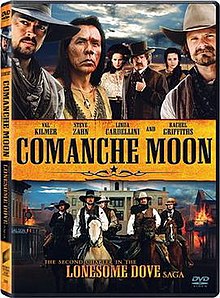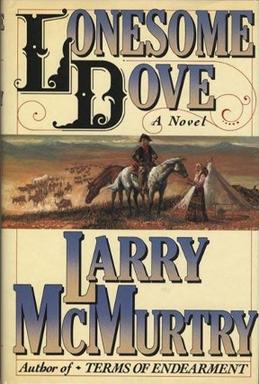
Lonesome Dove is a 1985 Western novel by American writer Larry McMurtry. It is the first published book of the Lonesome Dove series and the third installment in the series chronologically. It was a bestseller and won the 1986 Pulitzer Prize for Fiction. In 1989, it was adapted as a TV miniseries starring Tommy Lee Jones and Robert Duvall, which won both critical and popular acclaim. McMurtry went on to write a sequel, Streets of Laredo (1993), and two prequels, Dead Man's Walk (1995) and Comanche Moon (1997), all of which were also adapted as TV series.
The Lonesome Dove series is a series of four Western fiction novels written by Larry McMurtry and the five television miniseries and television series based upon them.

Larry Jeff McMurtry was an American novelist, essayist, and screenwriter whose work was predominantly set in either the Old West or contemporary Texas. His novels included Horseman, Pass By (1962), The Last Picture Show (1966), and Terms of Endearment (1975), which were adapted into films. Films adapted from McMurtry's works earned 34 Oscar nominations. He was also a prominent book collector and bookseller.
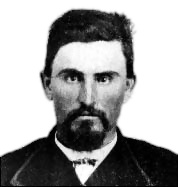
Charles Goodnight, also known as Charlie Goodnight, was a rancher in the American West. In 1955, he was inducted into the Hall of Great Westerners of the National Cowboy & Western Heritage Museum.

Comanche Moon (1997) is a Western novel by American writer Larry McMurtry. It is the fourth and final book he published in the Lonesome Dove series. In terms of chronology, it is the second installment of the narrative. A Comanche Moon in Texas history was a full moon in autumn which permitted Comanche warriors to ride by night journeying southward to raid Mexico for livestock and captives.

The Comanche Wars were a series of armed conflicts fought between Comanche peoples and Spanish, Mexican, and American militaries and civilians in the United States and Mexico from as early as 1706 until at least the mid-1870s. The Comanche were the Native American inhabitants of a large area known as Comancheria, which stretched across much of the southern Great Plains from Colorado and Kansas in the north through Oklahoma, Texas, and eastern New Mexico and into the Mexican state of Chihuahua in the south. For more than 150 years, the Comanche were the dominant native tribe in the region, known as “the Lords of the Southern Plains”, though they also shared parts of Comancheria with the Wichita, Kiowa, and Kiowa Apache and, after 1840, the southern Cheyenne and Arapaho.

Streets of Laredo is a 1993 Western novel by American writer Larry McMurtry. It is the second book published in the Lonesome Dove series, but the fourth and final book chronologically. It was adapted into a television miniseries in 1995.

Dead Man's Walk is a 1995 Western novel by American writer Larry McMurtry. It is the third book published in the Lonesome Dove series but the first installment in terms of chronology. McMurtry wrote a fourth segment to the Lonesome Dove chronicle, Comanche Moon, which describes the events of the central characters' lives between Dead Man's Walk and Lonesome Dove. The second novel in the Lonesome Dove series was the 1993 sequel to the original, called Streets of Laredo. Dead Man’s Walk was later adapted into a three-part miniseries of the same name, which aired in May 1996.
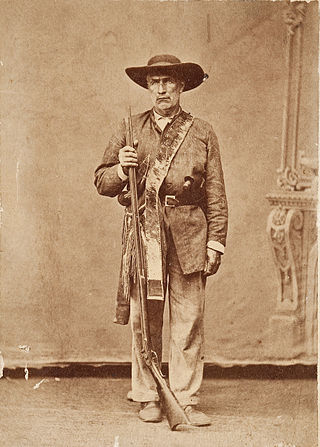
William Alexander Anderson "Bigfoot" Wallace was a Texas Ranger who took part in many of the military conflicts of the Republic of Texas and the United States in the 1840s, including the Mexican–American War.
Buffalo Hump was a War Chief of the Penateka band of the Comanches. He came to prominence after the Council House Fight when he led the Comanches on the Great Raid of 1840.
The Battle of Plum Creek was a clash between allied Tonkawa, militia, and Rangers of the Republic of Texas and a huge Comanche war party under Chief Buffalo Hump, which took place near Lockhart, Texas, on August 12, 1840, following the Great Raid of 1840 as the Comanche war party returned to west Texas.

The Great Raid of 1840 was the largest raid ever mounted by Native Americans on white cities in what is now the United States. It followed the Council House Fight, in which Republic of Texas officials attempted to capture and take prisoner 33 Comanche chiefs and their wives, who had earlier promised to deliver 13 white captives they had kidnapped. Because of the poor amount this Penateka band of Southern Comanche received for the ransom of nine year old, James Putnam weeks before, they only brought a 16-year-old Matilda Lockhart. Just as they had done to the Mexican's and Santa Fe'ans for nearly a century, the Penaketa wanted to ensure they'd received a higher payment before ransoming the other whites they had abducted. This tactic, together with the terrible treatement they had wrought on Miss Lockhart backfired and the Indians found themselves taken hostage for a prisoner exchange. An attempt to escape, followed by the brandishing of knives, tomahawks the Comanche had secreted between their wives' blankets led to the massacre of all the male Indians except two elderly men, who along with the women were taken hostage.

The Council House Fight, often referred to as the Council House Massacre, was a fight between soldiers and officials of the Republic of Texas and a delegation of Comanche chiefs during a peace conference in San Antonio on March 19, 1840. About 35 Comanche men and women under chief, Mukwooru represented just fraction of the Penateka band of the southern portion of the Comanche tribe. He knew he had no authority to speak for the Southern tribes as a whole and thus, any discussions of peace would be simply a farce. However, if Mukwooru could re-establish a lucrative trade with the San Antonian's perhaps a peace, by proxy, could be established. Just as the Comanche had done had been done for centuries in San Antonio, Santa Fe and along the Rio Grande. They would rob one settlement and sell to the other.
The Texas–Indian wars were a series of conflicts between settlers in Texas and the Southern Plains Indians during the 19th-century. Conflict between the Plains Indians and the Spanish began before other European and Anglo-American settlers were encouraged—first by Spain and then by the newly Independent Mexican government—to colonize Texas in order to provide a protective-settlement buffer in Texas between the Plains Indians and the rest of Mexico. As a consequence, conflict between Anglo-American settlers and Plains Indians occurred during the Texas colonial period as part of Mexico. The conflicts continued after Texas secured its independence from Mexico in 1836 and did not end until 30 years after Texas became a state of the United States, when in 1875 the last free band of Plains Indians, the Comanches led by Quahadi warrior Quanah Parker, surrendered and moved to the Fort Sill reservation in Oklahoma.
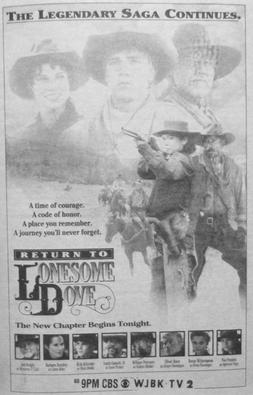
Return to Lonesome Dove is a 1993 American four part television miniseries, written by John Wilder involving characters created in Larry McMurtry's Western novel Lonesome Dove which was broadcast by CBS and first aired on November 14–17, 1993. The story focuses on a retired Texas Ranger and his adventures driving mustangs from Texas to Montana. It was nominated for an Emmy Award, and followed by Lonesome Dove: The Series.
The Neighbors Expedition, led by Robert Neighbors was one of several expeditions sent by the military to explore the area between San Antonio and El Paso with the purpose of opening a practical road to the west, which could be used by settlers and stages. The Neighbors Expedition, along with that led by Col. John C. Hays of the Texas Rangers in 1848, and that of Lieutenants William Henry Chase Whiting and William F. Smith of the United States Army Corps of Engineers in 1849, were the most important of these expeditions.

Lonesome Dove is a 1989 American epic Western adventure television miniseries directed by Simon Wincer. It is a four-part adaptation of the 1985 novel of the same name by Larry McMurtry and is the first installment in the Lonesome Dove series. The novel was based upon a screenplay by Peter Bogdanovich and McMurtry. The miniseries stars an ensemble cast headed by Robert Duvall as Augustus McCrae and Tommy Lee Jones as Woodrow Call. The series was originally broadcast by CBS from February 5 to 8, 1989, drawing a huge viewing audience, earning numerous awards, and reviving both the television Western and the miniseries.
Larry McMurtry's Streets of Laredo is a 1995 American Western television miniseries directed by Joseph Sargent. It is a three-part adaptation of the 1993 novel of the same name by author Larry McMurtry and is the third installment in the Lonesome Dove series serving as a direct sequel to Lonesome Dove (1989), ignoring the events of Return to Lonesome Dove (1993). The series is set in the 1890s.
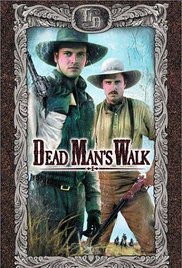
Dead Man's Walk is an American epic Western adventure television miniseries starring David Arquette as Augustus McCrae and Jonny Lee Miller as Woodrow F. Call. It was directed by Yves Simoneau. It is a two-part adaptation of the 1995 novel of the same name by Larry McMurtry and is chronologically the third book of the Lonesome Dove series, but regarded as the first events in the Lonesome Dove franchise. In this prequel to Lonesome Dove, it is 1840s Texas, and two young men join the Texas Rangers unit that's on a mission to annex Santa Fe. While the miniseries has been broken up into 3 parts for the DVD release, the series was originally broadcast by ABC over two nights in May 1996, and was later nominated for several awards.
Yellow Wolf, Spirit Talker 's nephew and Buffalo Hump 's cousin and best support, was a War Chief of the Penateka division of the Comanche Indians. He came to prominence after the Council House Fight, when Buffalo Hump called the Comanches and, along with Yellow Wolf and Santa Anna, led them in the Great Raid of 1840.
